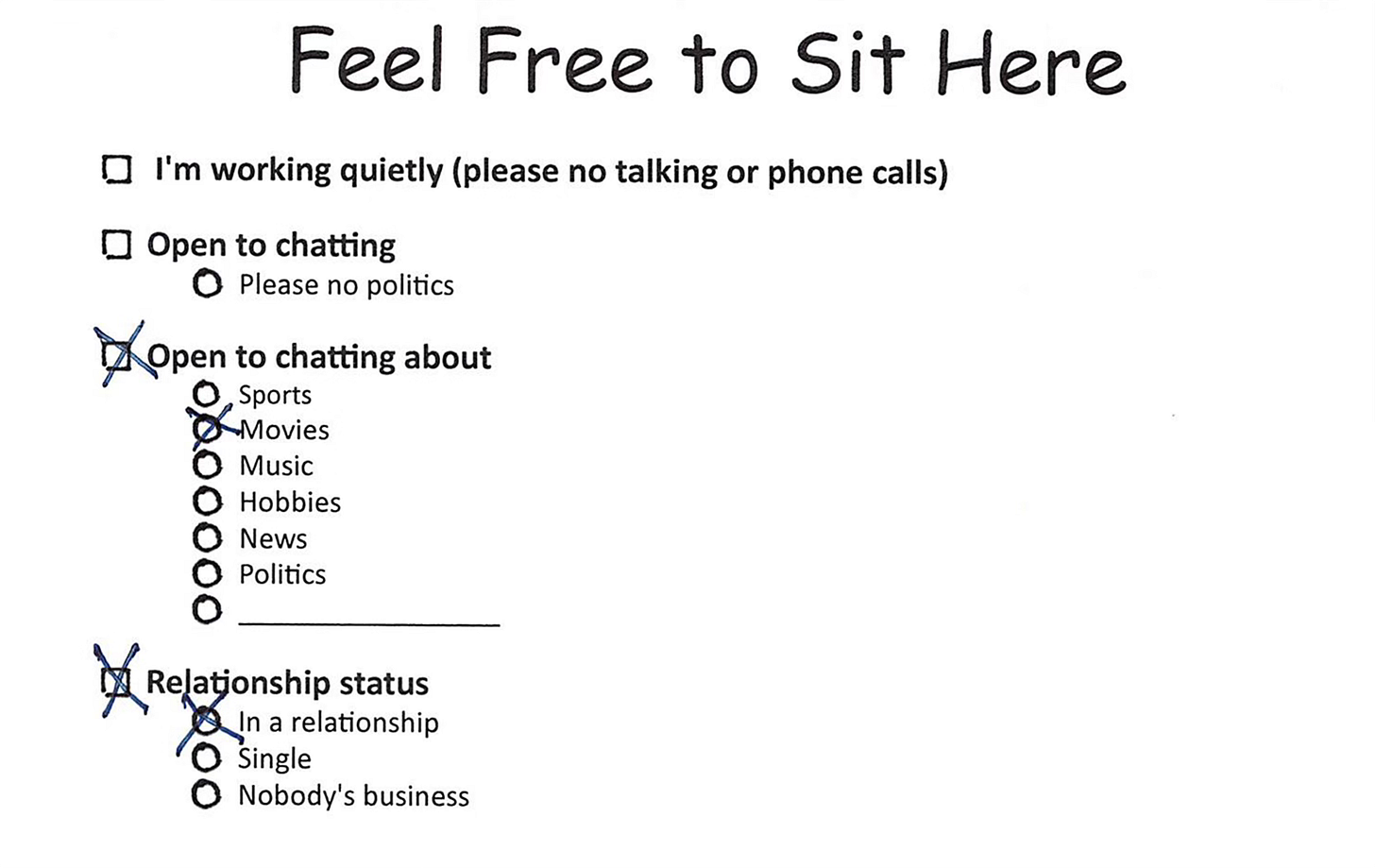Escape the Digital Cocoon
The only way to reduce polarization is to talk with people in real life. Here's one way to do just that *and* find a seat at a coffee bar. Plus, ChatGPT 5, TikTok and the News, and more! (Issue #177)
Before we get to today's main topic, some miscellaneous goodies and things worth your attention…
Guy Kawasaki's Remarkable People podcast interviewed Harvard's Todd Rogers about his new book, written with Jessica Lasky-Fink, Writing for Busy Readers. One of the few topics about which La Profesora and I disagree is the purpose of writing. I think that all writing is about persuasion. She does not. Rogers is closer to my side. Halfway through the episode I ordered the book.
ChatGPT 5 launched this week to much fanfare and skepticism. Peter Horan's Digital Trends article about the launch is a succinct and helpful overview.
My take? How wow! the upgrade is depends on your frame of reference. If you compare it to the first version of ChatGPT or Siri or Alexa, then it’s a moderately big deal. If you compare it to the claims that AI boosters make about the future of humanity intertwining with AI down to the molecular level, then it’s just nice… like the hop from an iPhone 12 to an iPhone 16.
As I’ve written elsewhere, humans have “adapt-amnesia,” where we quickly pivot our behavior into a new technology and forget how much our lives have changed because of it. Incremental changes among AI models aren’t as interesting to me as the massive behavior changes in the "before AI" to "after AI" leap.
For those of us who remember when “the year of mobile” happened for several years in a row… until we realized it was in the rear view mirror around 2007—or for those of us who have read Wordsworth’s The Prelude and remember when the poet realized, whoops, that he had already crossed the Alps—the move from 4 to 5 is like that.
She's going to win another Pulitzer for this: Don't miss Emily Steel's harrowing NYT ($) article about how there is a sexual assault in an Uber ride every eight minutes, and what the company has and has not done about it. Friday's episode of The Daily is also about this remarkable reporting. (H/T Elise Neel.)
I've decided not to renew my subscription to The Washington Post. The exodus of top-flight reporters and columnists combined with the new editorial direction to cover only the news that's groovy has emptied the paper of its value. La Profesora and I will increase our monthly donation to NPR instead.
TiKTok and the News: It's not news that a lot of people, particularly younger folks, get a lot of their news from TikTok. Pew had a startling study about this a year ago. Don't miss Amogh Dimri's insightful Atlantic Monthly ($) piece, "This Is the News From TikTok" that digs into the scary implications.
I couldn't stop watching this creepy, dystopian, AI-generated video of the current administration living the high life while the MAGA base starves and what comes after. (H/T Ellen Retting.)
This article, "Left-Wing Group Too Disorganized For FBI Agents To Infiltrate," from The Onion made me smile and wince. (H/T Freddy Tran Nager.)
On the lighter side...
End of an era: AOL's dial-up service will end on September 30, 2025. H/T Adam Boettiger, who also shared this audiofile of the iconic "You've Got Mail!" notification.
One of the reasons I write The Dispatch on Sunday mornings is that La Profesora is typically rowing at that time. Here's a Facebook video that shows what she's doing while I'm writing.
Wednesday is back on Netflix! I enjoyed the first episode. The already large cast has gotten bigger, so it might be hard for new viewers to jump on here. Fortunately, the excellent first season is right there for binge viewing.
If you like what you're reading, please forward to a friend. Sign up is here.
Practical Matters:
Sponsor this newsletter! Let other Dispatch readers know what your business does and why they should work with you. (Reach out here or just hit reply.)
Hire me to speak at your event! Get a sample of what I'm like onstage here.
The idea and opinions that I express here in The Dispatch are solely my own: they do not reflect the views of my employer, my consulting clients, or any of the organizations I advise.
Please follow me on Bluesky, Instagram, LinkedIn, and Threads (but not X) for between-issue insights and updates.
On to our top story...
Escape the Digital Cocoon
A while back, I was thinking about how our behavior would change as augmented reality (AR) and virtual reality (VR) became common. (This still hasn't happened.)
My recurring fantasy: once we were all looking at life through special lenses with information overlays, it would be easier to find a place to sit at a coffee bar.
This was just one of my AR fantasies. I also thought that conferences would be easier if my smartglasses displayed arrows connecting names to faces. "Gretchen Smith," the name hovering over a woman's head would read. If I stared at the name or blinked, then more information would unfurl reminding me about my last email exchange with Gretchen, how we first met, etc.
This would spare me either, a) the mild panicked expression that crosses my face when somebody at a conference knows me but I have no clue who they are, or b) when a woman has a lanyard with her name and company conveniently legible but inconveniently at precise nipple longitude—so when trying to determine her name I also wind up looking at her chest, which is not a great way to start a chat, and which can result in another mild panicked expression.
Back to the coffee bar fantasy…
At Peet's by preference, after collecting my oat milk, vanilla latte with an extra shot—yes, I'm one of those people—I'd gaze through my AR glasses and see where a person sitting alone at a table built for two or three or four was open to my joining them. An invisible sign would hover over the table: "Feel Free to Sit Here" with other information like, "I'm working" or "I'm happy chat, just not about politics."
This magical sign would let me bypass the awkward, "hey, do you mind if I sit here?" that might provoke a horrified look that would spoil my latte.
By now, you might be thinking two things:
I worry too much in coffee bars;
Why do I need AR to solve this problem?
I can't do too much about #1 (besides therapy), but for #2 the answer is no. Using AR for this is digital advanced technology looking for a problem to solve where a piece of paper works just as well.
My solution for finding a place to sit at a coffee bar
(which has other benefits) is this sign:
My mood will determine how I fill out the sign. For example, if I'm feeling chatty but don't want to talk politics:
If enough people think that this sort of sign is a good idea, and if enough people print and fill them out, then finding a seat in a busy Peet's or Starbucks will get easier.
Want to give this a try? You can print out a blank version of the sign here; it's easy-to-fold and prop on your table.**
What are the other benefits?
We spend so much time cocooned in our digital worlds where we either interact with people we already know or get in fights with people we don't know but who social media algorithms decide will rile us up and keep us on the platform so that the social media company can sell more ads.
We are losing the middle ground where we can chat with nearby people we don't know.
I blame Tinder.
Why? Because Tinder (and Bumble, Happn, Grindr and other apps) removed the great source of friction and terror from finding somebody of the desired gender: they took out the awkward, "um, hey" where you had no idea if the other person would smile, laugh at you, or react in an unnerving way that suggested psychosis.
For those of you who don't know, Tinder pops an endless series of pictures of people you might want to... date... onto your smart phone. If you swipe right, you're open to talking with that person. If you swipe left, you aren't. Tinder doesn't tell you who has rejected you, so you only match with people when both of you have swiped right. Tinder users already know that the other person is willing to talk. That's cheating!
(La Profesora and I have been married since before the world wide web, smartphones, social media, and online dating, so my outrage about this is entirely on behalf of my younger self.)
Of course, it's not just Tinder. The internet has taken friction out of interactions with our fellow humans in many ways, which has trapped us in our digital cocoons.
We can break out of our digital cocoons through analog means, talking with people we don't know, with whom we might not agree about a lot of things, but with whom we might find common ground about other things.
A coffee bar is one place to start.
Thanks for reading. See you next Sunday.
* Image Prompt: "Please create a photorealistic image of a clothed man emerging vertically out of a translucent cocoon. We are looking at the image from the man's left side, so his nose is pointing right. We can see that one of the man's hands has broken through the top of the cocoon, and the top of his head has emerged. The cocoon sits in an otherwise empty gray space. The bottom two thirds of the cocoon are textured like a butterfly's chrysalis. The top third is more translucent so that we see the shape of the man's body." (It took several tries and several different image generators.)
** Years ago, my friend David Daniel had a similar idea, which was a sign that airline passengers could stick on the back of the seat in front of them that said either, "Please wake me for food" or "Please don't wake me for food." That idea was part of my inspiration for this piece.



